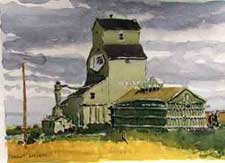
| Home | Search | Sitemap | Help | Contact | Sponsors |
|
|

|

|

|

|
| Home >> Article Database >> How Will We Find Our Way Home? | |||
|
How Will We Find Our Way Home? By Judy Larmour Why Do Such an Expensive and Time-consuming Inventory?
Who remembers names such as Rose Lynn, Buoyant, Fleet, Entice, Norma, Pivot, Wessex and Navarre? The grass has long grown over where the elevators stood at these places and hundreds of other elevators have fallen to a similar fate in the last two years. The impressive rows that characterized Alberta’s landscape by 1920 are gone or quickly fading elevator by elevator, like a toothless grin against the horizon. In 1934 Alberta boasted 1,755 licensed elevators, but the number had dwindled to a mere 327 by the end of 1996-97, with a large percentage of these slated for imminent demolition.
In spring of 1997 the Western Canadian History Program at the Provincial Museum of Alberta (PMA) announced a major project to document and evaluate the physical, social and economic role played by the grain elevator in rural communities. When I was hired as research consultant, the enormity and complexity of researching this vanishing aspect of our prairie economy became clear. The knowledge and participation of my partner Les Bergen, a farmer with good research skills, was crucial to planning and carrying out the project. My first task was to photo-document all elevators remaining on their original rail site to produce an inventory for 1997. And not a moment too soon! Using maps showing abandoned lines and former grain delivery points, I travelled the length and breadth of Alberta to record each elevator complex. Basic documentation followed the regular procedures and format used for the Heritage Inventory Program of the Historic Sites Service. This involved taking black and white photographs of the elevator complex and its component structures, such as annexes, warehouses and offices, from different positions to record at least four elevations. Extensive field notes were taken on descriptive details such as foundation type, roof type, whether the structure was clad with metal or siding, what structural alterations had been made, recording of ghost signs, interior workings of the elevator, recording old-style dump mechanisms, as well as the landscape context.
It was a pretty hectic and very hot and dusty summer. And of course, the weather did not always co-operate by November! Field work included the logistics of finding a motel room that was not booked by an oil company for its employees, avoiding getting run over by trains and getting covered in grain dust, to finding telephones at the right moment to co-ordinate various arrangements. The real challenge however, was simply to keep up with the elevator demolition crews. On all but two occasions, after several mad dashes to the far reaches of the province, I managed to get my photographs before the track hoe moved in. Salvaging items from the elevators became my concerted aim. With the co-operation of the grain companies, and sometimes the assistance of the demolition crew, we were able to salvage a considerable range of artifacts for the museum. These included long lengths of the grain work, wood of the elevator leg, a kicker for testing dockage, bin slides, air compressor taps, a car mover, a large collection of notices from elevator walls, a hopper, sample boxes, office furniture, distributor wheel, manlift—just about anything that would fit in several half-ton truck loads. In the end, 526 elevators were recorded in over 239 locations. These included elevators still in operation, abandoned elevators and privately owned structures. |
|||





 Why is this happening? It’s not a new trend: elevators have been demolished from the 1960s. Between 1971 and 1981, 141 delivery points were taken off the map, leaving a total of 979 licensed elevators. This new round of demolition is, however, fundamentally different in that the country elevator as a concept is being made obsolete. Changing trends in the grain industry, the end of the Crow rate in 1996 and rail deregulation have resulted in the abandonment of branch lines that had been threatened from the late 1960s. These trends resulted in a massive acceleration in the rate of closure of elevators, as the traditional wooden country elevators are replaced by concrete silo-high through-put regional terminals currently under construction, which can handle 52 car trains.
Why is this happening? It’s not a new trend: elevators have been demolished from the 1960s. Between 1971 and 1981, 141 delivery points were taken off the map, leaving a total of 979 licensed elevators. This new round of demolition is, however, fundamentally different in that the country elevator as a concept is being made obsolete. Changing trends in the grain industry, the end of the Crow rate in 1996 and rail deregulation have resulted in the abandonment of branch lines that had been threatened from the late 1960s. These trends resulted in a massive acceleration in the rate of closure of elevators, as the traditional wooden country elevators are replaced by concrete silo-high through-put regional terminals currently under construction, which can handle 52 car trains. In addition, I took hundreds of colour prints and slides for the museum’s photo collection. I also shot many hours of video footage that documents the structure of the elevators, as well as capturing demolitions and activities such as trucks emptying their loads, grain cars being filled, the demonstration of various procedures by elevator agents, and the running of one of the last privately owned gas engine-powered rope-driven elevators in operation, complete with sound effects! Field work also included co-ordinating oral history interviews with elevator agents, farmers, a member of an elevator construction crew, and local information gathering.
In addition, I took hundreds of colour prints and slides for the museum’s photo collection. I also shot many hours of video footage that documents the structure of the elevators, as well as capturing demolitions and activities such as trucks emptying their loads, grain cars being filled, the demonstration of various procedures by elevator agents, and the running of one of the last privately owned gas engine-powered rope-driven elevators in operation, complete with sound effects! Field work also included co-ordinating oral history interviews with elevator agents, farmers, a member of an elevator construction crew, and local information gathering.